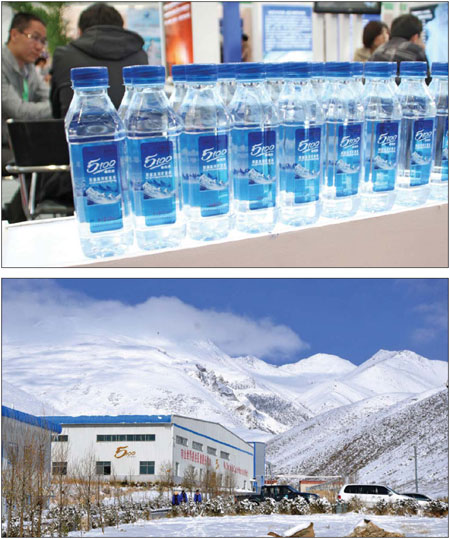

Top: Tibet 5100's bottled mineral water is on display during a promotion in Beijing in 2012. Below: The company's workshops in Tibet. The source of the water is the Qu Ma Nong Spring, which is 5,100 meters above sea level. Photos Provided to China Daily
Tibet Autonomous Region, in southwest China, has identified its fresh water resources as a new sustainable economic growth pillar, which has the potential to support efforts to reduce poverty and boost industrial development in the region.
Positioned on the world's highest plateau, Tibet is often called Asia's Water Tower, and many of the world's greatest rivers flow out of the Tibetan Plateau. Unlike the rest of the country, which is struggling with water shortages and deteriorating water environment, Tibet boasts a pristine environment and has a large repository of freshwater.
Sources at an ongoing annual regional people's congress session said the region had explored 28 mineral water springs and had reported 190 million tonnes of water reserves.
Speaking at the opening of the congress on Sunday, Losang Jamcan, chairman of Tibet's regional government, said Tibet produced 300,000 tonnes of bottled water in 2014, and the sector was an important driver of economic growth.
He pointed out that to fully exploit its potential, Tibet needed brand-driven strategies to prompt further growth in the sector.
Investment, mainly from the central government, has long supported growth in Tibet.
The region aims to maintain 2014's growth rate of 12 percent this year, while striking a balance between economic development and environmental protection. As a result, the mineral water industry has been singled out as a suitable sector to boost the local economy.
Deputy director of Tibet's industry and information technology bureau, Qiu Chuan, said transportation infrastructure projects and strong market demand for high-quality mineral water had upped investors' confidence in Tibet's mineral water industry.
So far, the region has 30 mineral water production lines with a combined production capacity of 2 million tonnes a year.
Leading bottled water producers, including Nongfu Spring and Bright Food Group, have signed 16 cooperative agreements with the regional government on mineral water development, promising investment of 3.6 billion yuan (5.79 million US dollars).
The regional government aims to boost the industry value to 40 billion yuan by 2019.
Tourism revenue surges in Tibet
2015-01-20Tibet maintains ambitious growth target with strong investment
2015-01-19Improved medicare makes delivery safer across Tibet
2015-01-1613 items from Tibet listed as National Intangible Cultural Heritage
2015-01-13Tibet sees record high tourist arrivals in 2014
2015-01-12Copyright ©1999-2018
Chinanews.com. All rights reserved.
Reproduction in whole or in part without permission is prohibited.